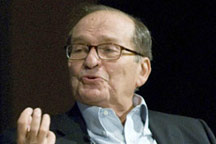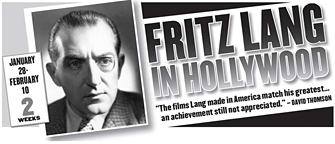The great Henry Fonda was born 108 years ago today. If we were to try to post even a sampling of the great work he did, we would be here all day, so instead, we decided to share with you his appearance on perhaps our favorite television show ever.
Tag: Henry Fonda
The curtain is drawn on a great director
 In February 2008, NYC’s Film Forum held a tribute to director Sidney Lumet, who died today at the age of 86. The celebration of Lumet’s life and career took the form of a two-hour Q&A, interspersed with clips from some of his most memorable films. We were lucky enough to be on hand, and we are pleased to offer, as a tribute to a very talented movie maker, our account of the evening.
In February 2008, NYC’s Film Forum held a tribute to director Sidney Lumet, who died today at the age of 86. The celebration of Lumet’s life and career took the form of a two-hour Q&A, interspersed with clips from some of his most memorable films. We were lucky enough to be on hand, and we are pleased to offer, as a tribute to a very talented movie maker, our account of the evening.
Lumet shared in the early part of the discussion that his father, Baruch, was an actor in the Yiddish theatre, and Sidney himself got his start there at a very early age.
Lumet went on to appear in a number of Broadway shows, among them a Max Reinhardt production, before slipping behind the camera as a television director in the 1950s.
So it was fitting that the evening opened with a clip from One Third of a Nation (1939), which boasts Lumet’s only film acting appearance. The then-14-year-old director-to-be starred as the nephew of Sylvia Sidney.
The next clip shown was from the first movie he directed, Twelve Angry Men (1957). Asked if he’d made a specific effort to make the film in a cinematic style, so as to prove to the industry bigwigs that he could direct as well for the large screen as for the small, Lumet admitted with a laugh, “I was too arrogant. It never occurred to me that I might need to convince anyone.”
Asked later about working with Henry Fonda, Lumet said Fonda was constitutionally unable to make a false or dishonest move as an actor. “I don’t think he could’ve done it if I’d asked him to,” Lumet said. “He could only play the truth.”
Lumet said that filming on Twelve Angry Men was completed in 19 days. He said he shot the film in a very particular way. There were three levels of lighting in the film—sunlight through the windows, cloudy skies, as a storm approached outside, and with the overhead lighting in the jury room illuminated once the storm is underway.
Lumet shot the film entirely out of sequence, rotating around the room, getting each shot he needed from each actor under that particular lighting. Once he’d shot all of his sunlit shots, Lumet had the set relit to suggest cloudy conditions and slowly worked his way around the room again, going from character to character, getting every shot he needed.
Finally, he had the set relit once last time, with overhead lighting lit, and made the rounds again.
Lumet said he never used storyboards, as Alfred Hitchcock was famous for doing. Instead, he preferred to rehearse his actors for two weeks, as if they were mounting a play, and when he had all the blocking down, then he considered where to place the camera in each scene.
Read More »
Film Forum fetes Fritz's hits
 If you’re anything like us and you happen to reside in or around New York City, you plan to make an almost daily pilgrimage to West Houston over the two weeks for “Fritz Lang in Hollywood,” a two-week retrospective at Film Forum.
If you’re anything like us and you happen to reside in or around New York City, you plan to make an almost daily pilgrimage to West Houston over the two weeks for “Fritz Lang in Hollywood,” a two-week retrospective at Film Forum.
The GermanAustrian-born Lang would be a revered figure in cinematic history even if he’d never set foot in Southern California. Such influential classics as Metropolis (1927), Spione (Spies, 1929), the Dr. Mabuse trilogy, and M (1931) ensure that.
But Lang became a very important director in the United States, too, beginning with his first Hollywood feature, Fury (1936), starring Spencer Tracy and Sylvia Sidney, which closes the Film Forum series as the 22nd of Lang’s 29 Hollywood pictures to be shown.
While in Hollywood, Lang showed a penchant for cinematic takes on pulp fiction—films noir, westerns, thrillers and espionage adventures—but he never settled for by-rote takes on these familiar genres. He gave his pictures a very particular look and dark mood, with the Expressionism of his making films in Germany clearlly influencing his American efforts.
You can’t go wrong with any of the bills during the series, but we especially recmommend the aforementioned Fury on Feb. 10; You Only Live Once (1937), starring Sidney and Henry Fonda, which is paired on Feb. 9th and 10th with Lang’s gangster musical (!) You and Me (1938), and three terrific noir double-bills: The Woman in the Window (1944)/Scarlet Street (1945 on Jan. 30, House by the River (1950)/The Blue Gardenia (1953) on Feb. 8, and the series-opener, The Big Heat (1953)/Human Desire (1954) on Jan. 28-29, both of which star noir royals Glenn Ford and Gloria Grahame.
If you’re familiar with Lang’s work, you’ve no doubt already got this great retrospective marked in your calendar. If you’re not, clear your calendar now and check out the series’ full line-up to plan which pictures you intend to see. You can thank us later.
